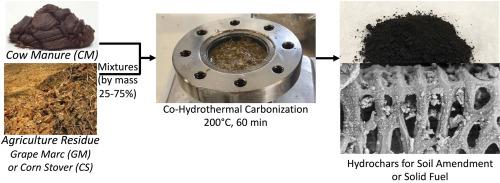Biomass & Bioenergy ( IF 5.8 ) Pub Date : 2022-01-13 , DOI: 10.1016/j.biombioe.2021.106329 Dylan Mariuzza 1 , Jui-Chun Lin 1 , Maurizio Volpe 2, 3 , Luca Fiori 3, 4 , Selim Ceylan 5 , Jillian L. Goldfarb 1

|
Hydrothermal carbonization (HTC) is a promising strategy to upcycle wet biomass wastes to carbon-condensed solid hydrochars. While cow manure is an ideal substrate for HTC in terms of its moisture content, resulting hydrochars lack any degree of aromatization and easily disintegrate under pressure. Such properties render manure hydrochars suboptimal soil amendments or solid fuels. We explore the co-hydrothermal carbonization of cow manure with two dry agricultural biomasses, grape marc and corn stover, to determine the degree to which mixing these biomasses improves the hydrochars’ soil amendment or solid fuel properties. Contrary to some prior literature, the co-HTC did not synergistically enhance solid yield or higher heating value, though it did increase the electrical conductivity of the hydrochars beyond an additive prediction. Overall, hydrochars have higher fixed carbon and lower H/C and O/C atomic ratios than their parent feedstocks, reducing their susceptibility to thermal degradation and decreasing the bioavailability of heavy metals. Given the potential to reduce phosphorous run-off via co-HTC, the land application of hydrochars could reduce eutrophication versus land application of raw manure. Despite these improvements over the raw feedstock, the surface areas and elemental carbon contents are still lower than most pyrolysis-based biochars. Higher heating values, relatively low ash content and reduced oxidative reactivity suggest that the blended hydrochars are likely better suited for utilization as a solid fuel than as a soil amendment.
中文翻译:

动物和农业废物的水热碳化对水炭土壤改良和固体燃料特性的影响
水热碳化(HTC)是将湿生物质废物升级为碳浓缩固体水炭的有前景的策略。虽然就其水分含量而言,牛粪是 HTC 的理想基质,但所得的水炭缺乏任何程度的芳构化,并且在压力下容易分解。这些特性使得粪肥水炭不是最理想的土壤改良剂或固体燃料。我们探索了牛粪与两种干燥的农业生物质葡萄渣和玉米秸秆的共热液碳化,以确定混合这些生物质对水炭土壤改良或固体燃料特性的改善程度。与一些先前的文献相反,co-HTC 并没有协同提高固体产量或更高的热值,尽管它确实增加了水炭的电导率,超出了添加剂的预测。全面的,与母体原料相比,水炭具有更高的固定碳和更低的 H/C 和 O/C 原子比,从而降低了它们对热降解的敏感性并降低了重金属的生物利用度。鉴于通过 co-HTC 减少磷径流的潜力,水炭的土地应用与生粪的土地应用相比,可以减少富营养化。尽管对原始原料有这些改进,但表面积和元素碳含量仍然低于大多数基于热解的生物炭。较高的热值、相对较低的灰分含量和降低的氧化反应性表明混合水炭可能更适合用作固体燃料而不是土壤改良剂。降低它们对热降解的敏感性并降低重金属的生物利用度。鉴于通过 co-HTC 减少磷径流的潜力,水炭的土地应用与生粪的土地应用相比,可以减少富营养化。尽管对原始原料有这些改进,但表面积和元素碳含量仍然低于大多数基于热解的生物炭。较高的热值、相对较低的灰分含量和降低的氧化反应性表明混合水炭可能更适合用作固体燃料而不是土壤改良剂。降低它们对热降解的敏感性并降低重金属的生物利用度。鉴于通过 co-HTC 减少磷径流的潜力,水炭的土地应用与生粪的土地应用相比,可以减少富营养化。尽管对原始原料有这些改进,但表面积和元素碳含量仍然低于大多数基于热解的生物炭。较高的热值、相对较低的灰分含量和降低的氧化反应性表明混合水炭可能更适合用作固体燃料而不是土壤改良剂。尽管对原始原料有这些改进,但表面积和元素碳含量仍然低于大多数基于热解的生物炭。较高的热值、相对较低的灰分含量和降低的氧化反应性表明混合水炭可能更适合用作固体燃料而不是土壤改良剂。尽管对原始原料有这些改进,但表面积和元素碳含量仍然低于大多数基于热解的生物炭。较高的热值、相对较低的灰分含量和降低的氧化反应性表明混合水炭可能更适合用作固体燃料而不是土壤改良剂。











































 京公网安备 11010802027423号
京公网安备 11010802027423号